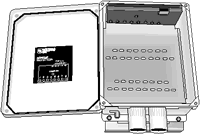This product is no longer available and has been replaced by: SDM8X50. Some accessories, replacement parts, or services may still be available.

| Services Available | |
|---|---|
| Repair | Yes |
| Calibration | No |
| Free Support | Yes |
Overview
The SDMX50 is available in a very limited supply. The SDMX50 will be replaced by the SDM8X50.
The SDMX50 is one of three 50 ohm, coaxial, 8:1 multiplexers that can be used in a TDR100-based system. It consists of a surge-protected multiplexer circuit board mounted in a 10" x 12" x 5" environmental enclosure. The enclosure's backplate provides a strain-relief point for the coaxial cables. Cable ties and desiccant are included.
Images

Compatibility
The SDMX50 is compatible with a TDR100-based system.
It's used when the multiplexer will be housed in its own enclosure (without the datalogger and power supply).
Specifications
| Outside Dimensions | 40.4 x 29.2 x 17.5 cm (15.9 x 11.5 x 6.9 in.) with mounts |
| Inside Dimensions | 25.4 x 30.4 x 12.7 cm (10 x 12 x 5 in.) for enclosure |
| Weight | 4.4 kg (9.8 lb) |
Power Requirements |
|
| Input Power | 12 Vdc |
| Quiescent Current Drain | < 1 mA |
| Current Drain during Switching | ~ 90 mA (all multiplexers of the same level switch simultaneously for less than 1 s) |
Related Documents
Related FAQs
Number of FAQs related to SDMX50: 7
Expand AllCollapse All
-
No. All SDMX50-series multiplexers in a TDR100 system may be connected to the same 12 V power supply.
-
The clicking sounds come from mechanical relays making and breaking their contacts.
-
Yes. PC-TDR can send control commands to advance through the channels of a SDMX50-series multiplexer. To do this, select Settings | Multiplexer and then add the multiplexers and probes that match the TDR100 system.
-
In applications where TDR probes are used to measure soil water content, the maximum distance from the TDR probe back to the TDR100 (even through one or more multiplexers) cannot exceed 15 m (50 ft) when using RG58 coaxial cable; the CS605-L, CS630-L, and CS640-L TDR probes have an RG58 cable. When using low-loss coaxial cable, the distance cannot exceed ≈25 m (80 ft); the CS610-L, CS635-L, and CS645-L TDR probes have a low-loss coaxial cable.
In slope stability and rock mass deformation applications, the maximum coaxial cable length should not exceed ≈1 mile (5,280 ft). The maximum combined length of all SDM cables in the system should not exceed ≈76 m (250 ft).
-
These three multiplexers all use the same relay board, but the housing differs. The multiplexers are described side-by-side on page 2 of this brochure.
The most popular model is the SDMX50SP, followed by the SDMX50.
-
PC-TDR is a free download in the Downloads section of this page.
Case Studies
The North County Transit District (NCTD) of San Diego County, California, determined that three segments......read more
The Charles Sturt University (CSU) Rhizolysimeter is one of the largest root-growth research facilities in......read more
When the Ohio Department of Transportation (Ohio DOT) was preparing to widen Interstate 77, they......read more

